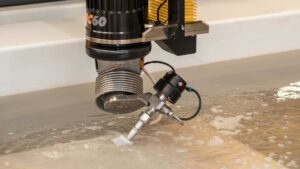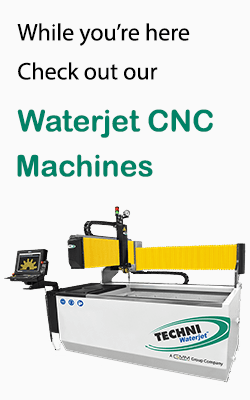Waterjet cutting is one of the most common processes in modern manufacturing and fabrication. With extensive benefits such as fewer airborne dust particles and no drawbacks, this cutting method is used in various applications, from cutting a few square feet of metal for fabrication to mining, arts and furniture production.
Due to the many different applications, various types of high-pressure water jet cutting methods have been developed suited to particular uses. Abrasive water jet machining is one of the most widely used waterjet techniques.
In this article, you will learn all about abrasive waterjet cutting, why it is used, and the different types of waterjet technology. Let’s get into the main topic right away.
What is Abrasive Waterjet Cutting?
In order to understand abrasive waterjet cutting, it is essential to know the basics of waterjet cutting itself.
Waterjet cutting is a cold cutting process. A very narrow stream of water is used to create an incision in the workpiece. Generally, the water jet is enough to create the cut, and the method is called Pure Waterjet Cutting.
However, when the thickness of the material increases or its density is hard, you need extra force besides the force of water. This additional force is achieved by adding abrasive particles to the water. These act as a high pressure fluid intensifier.
When the water stream containing the abrasive particles falls on the material to be cut at high pressure, it generates a lot of friction resulting in clean and precise cuts. The high-pressure flow of abrasive particles is generated by a reliable high-pressure pump attached to the waterjet cutting machine.
Popular abrasive particle options in waterjet cutting are silicon carbide, aluminum oxide, sand, and garnet. Garnet abrasive is the most common abrasive particle used due to its physical properties.
What is the purpose of using abrasive material in a water jet?
Pure water jet cutting can easily cut through soft materials like foam, paper, rubber, and thin plastics. However, with hard materials like metal, stone, and hard plastics, pure water cutting doesn’t work, or the process becomes too time-consuming.
Using abrasive particles with waterjet technology makes water jet cutting effective for cutting harder or thicker materials. With the addition of abrasives, all the benefits of waterjet cutting can be used on stainless steel, aluminum, copper, stone, and virtually any material.
Different types of abrasive water jet machining
Abrasive water jet machining is achieved by two different methods, so there are two types of abrasive water jet technology. The two methods differ in how the abrasive particle material is added to the cutting process.
Abrasive Water Injector Jet (AWIJ) Cutting:
In AWIJ cutting, the abrasive is added to high-pressure pump water after the nozzle and before the cutting head.
The abrasive and air is combined with water in the mixing chamber and sprayed out as an abrasive stream. After that, the water is ejected through the cutting head. This is a three-element cutting process; the three elements are waterjet technology, abrasive particles, and air.
Abrasive Water Suspension Jet (AWSJ) Cutting:
In AWSJ cutting, a suspension (liquid mixture) of water and abrasive particles is created and then pressurized at a later stage. This pressurized suspension is passed through a focusing nozzle (cutting head) which delivers the cutting action.
A significant difference between AWSJ cutting and AWIJ cutting is the absence of air in the AWSJ technique. Due to the absence of air, the pressurized water jet with abrasive grains does not expand during cutting, resulting in a lower kerf width and higher precision cuts.
So, an abrasive water suspension jet cutting tool can create faster cuts or efficiently cut thicker materials. AWSJ is also extensively used for underwater cutting applications, such as offshore installations or bomb disposal.
The pressurized water stream that comes out of the cutting head is a two-element cutting stream, using high-pressure water and abrasive.
What is the Difference Between Abrasive and Pure Waterjet Cutting?
Imagine you were cutting a sheet of paper with very blunt scissors or a dull cutting tool. They might get the job done but ruin the edges of the cut or crumple the paper itself. But if you make the cut with sharp scissors, you will get a clean and neat cut.
This is how abrasive waterjet and pure waterjet cutting function. Even if pure waterjet cutting can cut hard materials and soft materials, it will take a long time and the edges of the cut will be damaged.
Abrasive waterjet cutting does the job quickly, precisely, like a pair of sharp scissors, and conventional or pure waterjet cutting is like a pair of dull scissors.
But the advantages of abrasive waterjet cutting over traditional cutting methods and pure water cutting go beyond being able to cut softer materials more precisely.
Abrasive vs Pure water cutting
Here is an overview of how abrasive waterjet cutting differs from pure waterjet cutting.
Supported Workpiece Materials
Pure Waterjet Cutting: Pure waterjet cutting can be used to cut soft materials like food items, paper, foam, rubber, felt, and soft plastics.
Abrasive Waterjet Cutting: Abrasive waterjets can be used to cut virtually any material you can think of: carbon fiber, metals, hard plastics, ceramics, stone, glass, wood, earth, etc.
Speed
Pure waterjet cutting is obviously slower than abrasive waterjet cutting. Why? Because an abrasive waterjet has finer particles that create considerably greater friction, leading to a faster cutting speed.
Power
Both pure and abrasive waterjet cutting machines have similar power requirements. However, since the abrasive waterjet machine can do the job quickly, it will consume less power overall. Check our resource, to learn more about water jet cutting pressure.
Kerf
The water jet kerf is the amount of material removed during cutting (much like sawdust during woodworking). Pure waterjet cutting requires a longer time to cut the material. Water expands on leaving the cutting head, so the extended time leads to greater expansion and a higher level of kerf.
Thickness
As the water stream passes through the workpiece material, it loses momentum due to the material’s thickness. The addition of abrasives to the water increases the force of the water hitting the surface. Therefore, an abrasive waterjet machine can cut through a greater thickness of any material and cut harder materials.
Accuracy and Cutting Tolerances
Abrasive waterjet machines are well-known for their precision. As mentioned earlier, the difference between abrasive and pure waterjet cutters is similar to sharp and blunt scissors.
When should you use abrasive water jet cutting machines over pure waterjet cutters?
Abrasive waterjet machines will always create better cuts than pure waterjet cutters. This might make you wonder why you or anyone should even consider pure waterjet cutting for any project.
The answer to this is simple – the cost of abrasives. The cost of abrasives is the costliest overhead in abrasive waterjet cutting. Therefore, pure waterjet cutting is better for cutting projects that do not need abrasives.
Most of the projects that commonly employ pure waterjet cutting involve paper cutting, foam cutting, and rubber cutting. Other than these situations, those where hygiene is a factor (such as food cutting) also require pure waterjet cutting techniques.
On the other hand, any project dealing with fabrication, stone cutting, woodworking, or even cutting of hard rubber needs abrasive waterjet cutting.
Conclusion
Even though the science behind abrasive waterjet cutting has been used for more than a century, the latest machines still seem a marvel when you witness what they can achieve.
For example, the range of abrasive waterjet cutters provided by Techni Waterjet are used by fabrication workshops and aerospace projects. These machines are being used everywhere. They can cut through thick sheets of the hardest material like metal as if it were a single sheet of paper.
Are you thinking about buying a new cutting machine for your next project or your workshop? Then consider abrasive waterjet cutters.
Frequently Asked Questions (FAQs)
Which types of materials cannot be machined using abrasive jet machining?
Abrasive waterjet machining can cut almost any material except diamonds and tempered glass. In theory, you can cut any material using abrasive waterjet cutting, provided the abrasive is harder than the material to cut.





